Database Design: Critically Assessing Different Database Models and Principles of Relational Database Model
25 Pages5325 Words500 Views
Added on 2023-06-07
About This Document
This article discusses different database models such as file-based, hierarchical, and network model database systems, and the principles and structure of the relational database model. It also includes a conceptual model for Nova Cosmetics.
Database Design: Critically Assessing Different Database Models and Principles of Relational Database Model
Added on 2023-06-07
ShareRelated Documents
Anglia Ruskin University
BSc Computing (Information systems)
Database design
Nova Cosmetics
STU50613
Steve Presland
(???)
1
BSc Computing (Information systems)
Database design
Nova Cosmetics
STU50613
Steve Presland
(???)
1
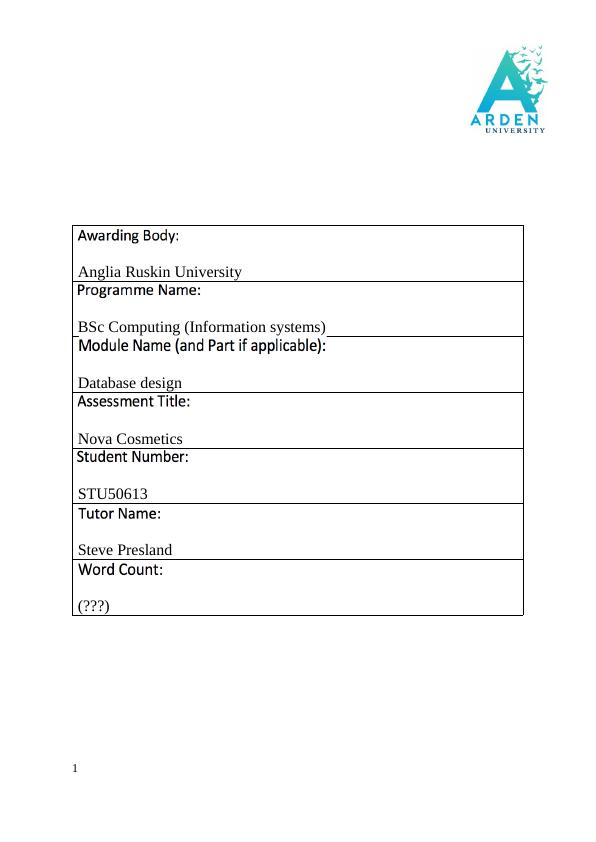
Table of Contents
Task 1 – Database systems.................................................................................................3
a. Critically assess the different database models that you know about and summarise their
respective advantages and disadvantages..................................................................................3
File based data-processing system...............................................................................................................3
Advantages of using a File based data-processing system...........................................................................4
Disadvantages of using a File based data-processing system.......................................................................4
Hierarchical based database system............................................................................................................4
Advantages of using a hierarchical based database system.........................................................................5
Disadvantages of using a hierarchical based database system....................................................................5
Network model database system.................................................................................................................5
Advantages of using a Network model database system.............................................................................6
Disadvantages of using a Network model database system........................................................................6
b. Using an example, discuss the principles and structure of the relational database mode....7
Relational Database system.........................................................................................................................7
Advantages of using a relational database system.......................................................................................8
Disadvantages of using a relational data base system.................................................................................8
Task 2 – Conceptual Model................................................................................................9
Task 3: Logical Model.......................................................................................................14
Task 4: Physical Model.....................................................................................................20
Bibliography....................................................................................................................24
2
Task 1 – Database systems.................................................................................................3
a. Critically assess the different database models that you know about and summarise their
respective advantages and disadvantages..................................................................................3
File based data-processing system...............................................................................................................3
Advantages of using a File based data-processing system...........................................................................4
Disadvantages of using a File based data-processing system.......................................................................4
Hierarchical based database system............................................................................................................4
Advantages of using a hierarchical based database system.........................................................................5
Disadvantages of using a hierarchical based database system....................................................................5
Network model database system.................................................................................................................5
Advantages of using a Network model database system.............................................................................6
Disadvantages of using a Network model database system........................................................................6
b. Using an example, discuss the principles and structure of the relational database mode....7
Relational Database system.........................................................................................................................7
Advantages of using a relational database system.......................................................................................8
Disadvantages of using a relational data base system.................................................................................8
Task 2 – Conceptual Model................................................................................................9
Task 3: Logical Model.......................................................................................................14
Task 4: Physical Model.....................................................................................................20
Bibliography....................................................................................................................24
2
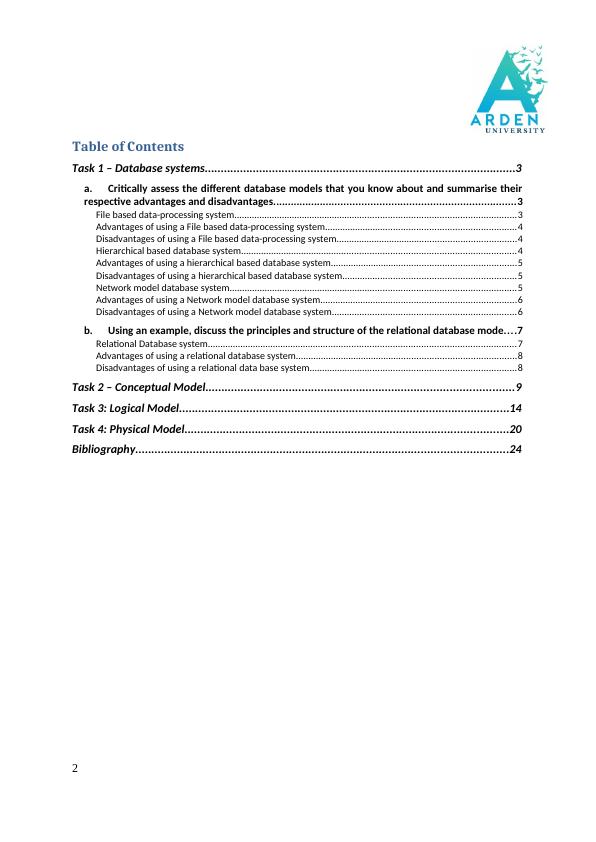
Task 1 – Database systems
(Word count = 1208)
a. Critically assess the different database models that you know about and
summarise their respective advantages and disadvantages.
File based data-processing system
A computer system store data in the form of bits and bytes over files that are structured in a
tree structure (Shroff, 2010).
1) Bit - The smallest form of data.
2) Byte - a collection of several bits which represents one character (e.g. letter, number).
3) Field - When combining bytes together into a while word then we create a field.
4) Record – When we group together fields like a student ,first and last name, his
modules, dates and his programme we create a record.
5) File - A group of similar records makes a file. a group of files makes a whole database
system.
The Data Hierarchy Louden & Louden (2017)
3
(Word count = 1208)
a. Critically assess the different database models that you know about and
summarise their respective advantages and disadvantages.
File based data-processing system
A computer system store data in the form of bits and bytes over files that are structured in a
tree structure (Shroff, 2010).
1) Bit - The smallest form of data.
2) Byte - a collection of several bits which represents one character (e.g. letter, number).
3) Field - When combining bytes together into a while word then we create a field.
4) Record – When we group together fields like a student ,first and last name, his
modules, dates and his programme we create a record.
5) File - A group of similar records makes a file. a group of files makes a whole database
system.
The Data Hierarchy Louden & Louden (2017)
3

Advantages of using a File based data-processing system
1) No equipment/material - Eliminates the need to use equipment and/or materials for
storing information (pages, pencil, pen) and to use hand writing which consumes time
and considered costly.
2) Organized structure - Provides a way to insert, delete and update data through a
hierarchal file structure (Shroff, 2010) where all files are kept within folders.
3) Easy Data processing - Provides the ability to search for data within files by either
using an application or the command line tool of the operating system in some cases.
Disadvantages of using a File based data-processing system
1) Data redundancy – As each file is related to a specific program and cannot be
shared with other programs data will begin to grow as we will store the same data
several times on different files.
2) Data inconsistency – Because that the same data is spread on different files, some
information might be up-to-date while other files will not contain the latest
information.
3) Program data dependence – Each application will use its own file as its source
of data making it very hard to commit changes.
4) Lack of flexibility – Since the data is coupled with each application there is no
way to retrieve data easily and such an operation can take weeks (if not months).
5) Poor security – There is a minimum amount of control for security and it is very
hard to manage.
6) Lack of data sharing and availability – It is hard to share the same data with
other departments in other regions in a timely manner.
Hierarchical based database system
The Hierarchical database contains:
1) Segment - The smallest form of data that IMS could store.
2) Fields – Segment contain fields (the smallest piece of data the an application can
manipulate). Each field contains a unique key field that can be used to locate a
segment within the database
3) Record – The tree-structure of all segments is the database record while the root
segment identifies a database record with depended segment which contain pieces
of data that relevant for the record.
4
1) No equipment/material - Eliminates the need to use equipment and/or materials for
storing information (pages, pencil, pen) and to use hand writing which consumes time
and considered costly.
2) Organized structure - Provides a way to insert, delete and update data through a
hierarchal file structure (Shroff, 2010) where all files are kept within folders.
3) Easy Data processing - Provides the ability to search for data within files by either
using an application or the command line tool of the operating system in some cases.
Disadvantages of using a File based data-processing system
1) Data redundancy – As each file is related to a specific program and cannot be
shared with other programs data will begin to grow as we will store the same data
several times on different files.
2) Data inconsistency – Because that the same data is spread on different files, some
information might be up-to-date while other files will not contain the latest
information.
3) Program data dependence – Each application will use its own file as its source
of data making it very hard to commit changes.
4) Lack of flexibility – Since the data is coupled with each application there is no
way to retrieve data easily and such an operation can take weeks (if not months).
5) Poor security – There is a minimum amount of control for security and it is very
hard to manage.
6) Lack of data sharing and availability – It is hard to share the same data with
other departments in other regions in a timely manner.
Hierarchical based database system
The Hierarchical database contains:
1) Segment - The smallest form of data that IMS could store.
2) Fields – Segment contain fields (the smallest piece of data the an application can
manipulate). Each field contains a unique key field that can be used to locate a
segment within the database
3) Record – The tree-structure of all segments is the database record while the root
segment identifies a database record with depended segment which contain pieces
of data that relevant for the record.
4
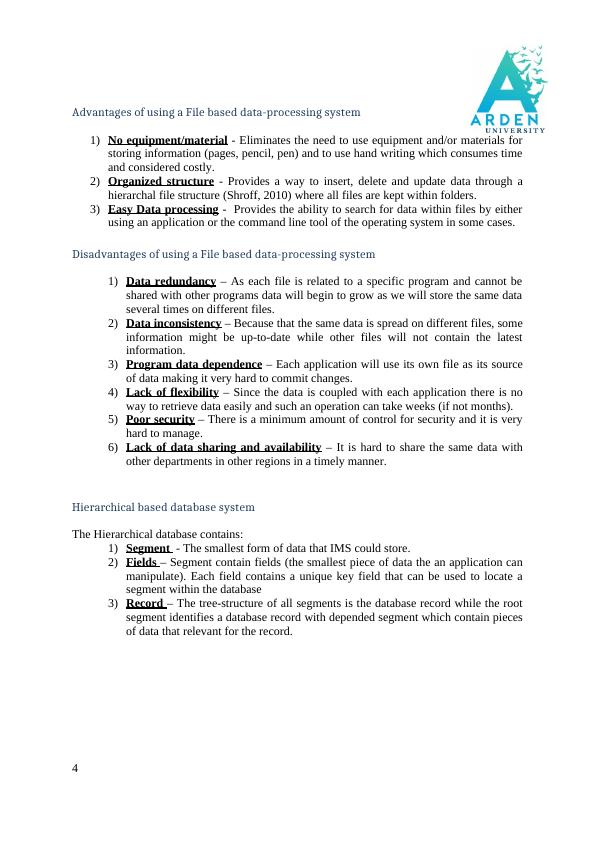
Example of a hierarchical structure (Powell, 2006):
Advantages of using a hierarchical based database system
1) Data Integrity – The IMS database provides a locking mechanism where only 1
application can write into the database at a time. Additionally the IMS is using a
logger that store changes made to the database by snapshots, which help restore data.
2) Security – By using the DRBC component the database can authorize requests from
an application.
3) Data sharing and availability – The DRBC also support concurrencies and allows
to share the data between several applications by using the DML interface.
Disadvantages of using a hierarchical based database system
1) Limited data independence – Same like with a file-based system, each application
will create its own depended data source and by that create challenges to update
information on a record for each record.
2) Lack of flexibility – Searching for information through the records will have to go
all the way from the root to the child’s in a recursive manner which will be a time
consuming operation. (Hoffer, et al., 2015) , additionally segments have fixed length
Network model database system
This system uses pointers that identifies the physical address of each record on the storage.
(Rai & Singh, 2015).
The model was designed to solve the lack of flexibility in the hierarchical database.
5
Advantages of using a hierarchical based database system
1) Data Integrity – The IMS database provides a locking mechanism where only 1
application can write into the database at a time. Additionally the IMS is using a
logger that store changes made to the database by snapshots, which help restore data.
2) Security – By using the DRBC component the database can authorize requests from
an application.
3) Data sharing and availability – The DRBC also support concurrencies and allows
to share the data between several applications by using the DML interface.
Disadvantages of using a hierarchical based database system
1) Limited data independence – Same like with a file-based system, each application
will create its own depended data source and by that create challenges to update
information on a record for each record.
2) Lack of flexibility – Searching for information through the records will have to go
all the way from the root to the child’s in a recursive manner which will be a time
consuming operation. (Hoffer, et al., 2015) , additionally segments have fixed length
Network model database system
This system uses pointers that identifies the physical address of each record on the storage.
(Rai & Singh, 2015).
The model was designed to solve the lack of flexibility in the hierarchical database.
5
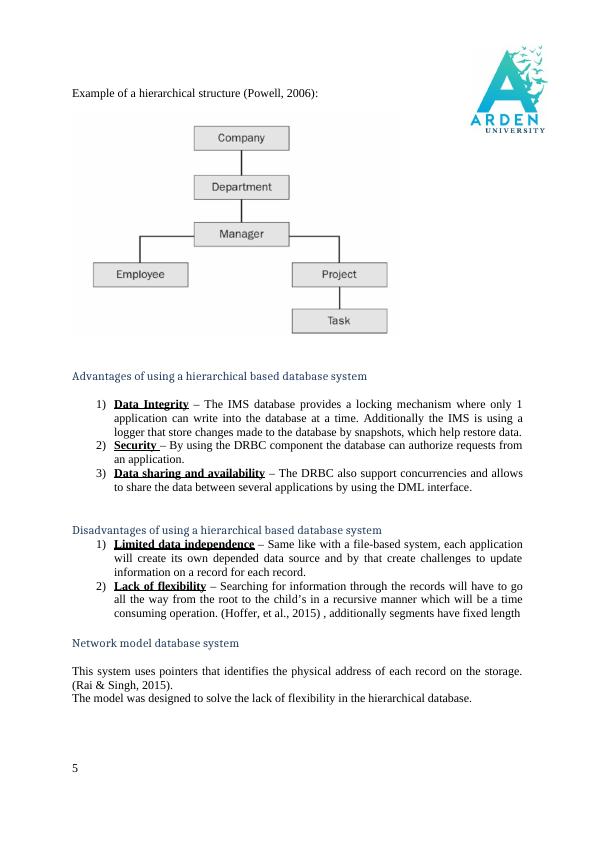
Example of a networking structure (Powell, 2006)
Advantages of using a Network model database system
1) Conceptual simplicity – easy to use and design
2) Support more relational types – Many-to-Many and one-to-many.
3) Ease of access – It is more easier to access data then in the hierarchical model.
4) Data independence – The network model separates the data from complex physical
storage information.
5) Meet Database Standards – The network model met the ANSI/SPARC (Thakur,
n.d.)
Disadvantages of using a Network model database system
1) System complexity – All the system relies on the pointers which makes it very
complex to manage.
2) Operational anomalies - Every insert, update and delete operation will require to
change many pointers which makes every operation difficult to perform.
3) Absence of structural independence – Making a change of the structural level is
very hard since the applications would have to be changed as well in order to work
with the database after such a change which raise another new data independence
challenges.
6
Advantages of using a Network model database system
1) Conceptual simplicity – easy to use and design
2) Support more relational types – Many-to-Many and one-to-many.
3) Ease of access – It is more easier to access data then in the hierarchical model.
4) Data independence – The network model separates the data from complex physical
storage information.
5) Meet Database Standards – The network model met the ANSI/SPARC (Thakur,
n.d.)
Disadvantages of using a Network model database system
1) System complexity – All the system relies on the pointers which makes it very
complex to manage.
2) Operational anomalies - Every insert, update and delete operation will require to
change many pointers which makes every operation difficult to perform.
3) Absence of structural independence – Making a change of the structural level is
very hard since the applications would have to be changed as well in order to work
with the database after such a change which raise another new data independence
challenges.
6
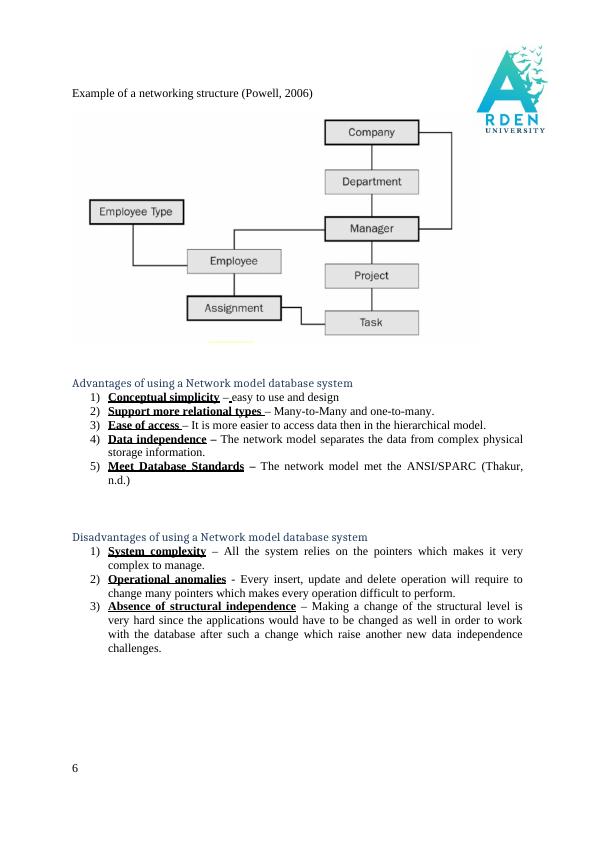
End of preview
Want to access all the pages? Upload your documents or become a member.
Related Documents
Logical Data Modeling Assignment PDFlg...
|10
|1481
|131
Database System for Jet Airlineslg...
|19
|2336
|329
Database Design and Implementationlg...
|15
|3038
|164
Database Design and Implementationlg...
|15
|3038
|167
Comparison of RDBMS with File Based System, Hierarchical, Network and Relational Database Modelslg...
|11
|2084
|140
Data Modelling & SQL Language: Assignmentlg...
|11
|1420
|93
